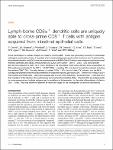Lymph-borne CD8α+ dendritic cells are uniquely able to cross-prime CD8+ T cells with antigen acquired from intestinal epithelial cells
Cerovic, V.
Houston, S. A.
Westlund, J.
Utriainen, L.
Davison, E. S.
Scott, C. L.
Bain, C. C.
Joeris, T.
Agace, W. W.
Kroczek, Richard
Mowat, A. M.
Yrlid, U.
Milling, S. W. F.
Cross-presentation of cellular antigens is crucial for priming CD8+ T cells, and generating immunity to intracellular pathogens—particularly viruses. It is unclear which intestinal phagocytes perform this function in vivo. To address this, we examined dendritic cells (DCs) from the intestinal lymph of IFABP-tOVA 232-4 mice, which express ovalbumin in small intestinal epithelial cells (IECs). Among lymph DCs (LDCs) only CD103+ CD11b− CD8α+ DCs cross-present IEC-derived ovalbumin to CD8+ OT-I T cells. Similarly, in the mesenteric lymph nodes (MLNs), cross-presentation of IEC–ovalbumin was limited to the CD11c+ MHCIIhi CD8α+ migratory DCs, but absent from all other subsets, including the resident CD8αhi DCs. Crucially, delivery of purified CD8α+ LDCs, but not other LDC subsets, into the MLN subcapsular lymphatic sinus induced proliferation of ovalbumin-specific, gut-tropic CD8+ T cells in vivo. Finally, in 232-4 mice treated with R848, CD8α+ LDCs were uniquely able to cross-prime interferon γ-producing CD8+ T cells and drive their migration to the intestine. Our results clearly demonstrate that migrating CD8α+ intestinal DCs are indispensable for cross-presentation of cellular antigens and, in conditions of inflammation, for the initial differentiation of effector CD8+ T cells. They may therefore represent an important target for the development of antiviral vaccinations.
Dateien zu dieser Publikation
Keine Lizenzangabe
Verwandte Publikationen
Anzeige der Publikationen mit ähnlichem Titel, Autor, Urheber und Thema.
-
2010-05-24ZeitschriftenartikelInducible costimulator (ICOS) blockade inhibits accumulation of polyfunctional T helper 1/T helper 17 cells and mitigates autoimmune arthritis Frey, Oliver; Meisel, Juliane; Hutloff, Andreas; Bonhagen, Kerstin; Bruns, Lisa; Kroczek, Richard; Morawietz, Lars; Kamradt, ThomasObjectives: Inducible costimulator (ICOS) and its ligand (ICOSL) regulate T and B cell responses. Glucose-6-phosphate isomerase (G6PI)-induced arthritis requires T and B lymphocytes. It was hypothesised that blocking ...
-
2016-02-26ZeitschriftenartikelLocal T/B cooperation in inflamed tissues is supported by T follicular helper-like cells Van, Dana Vu; Beier, Katja C.; Pietzke, Lea-Jean; Baz, Maysun S. Al; Feist, Randi K.; Gurka, Stephanie; Hamelmann, Eckard; Kroczek, Richard; Hutloff, AndreasAutoimmune diseases and other inflammatory conditions are characterized by large lymphocytic tissue infiltrates in which T and B cells can be found in close contact. Here, using a murine airway inflammation model, we compare ...
-
2013-04-15ZeitschriftenartikelGiardia duodenalis arginine deiminase modulates the phenotype and cytokine secretion of human dendritic cells by depletion of arginine and formation of ammonia Banik, Stefanie; Viveros, Pablo Renner; Seeber, Frank; Klotz, Christian; Ignatius, Ralf; Aebischer, ToniDepletion of arginine is a recognized strategy that pathogens use to evade immune effector mechanisms. Depletion depends on microbial enzymes such as arginases, which are considered virulence factors. The effect is mostly ...

